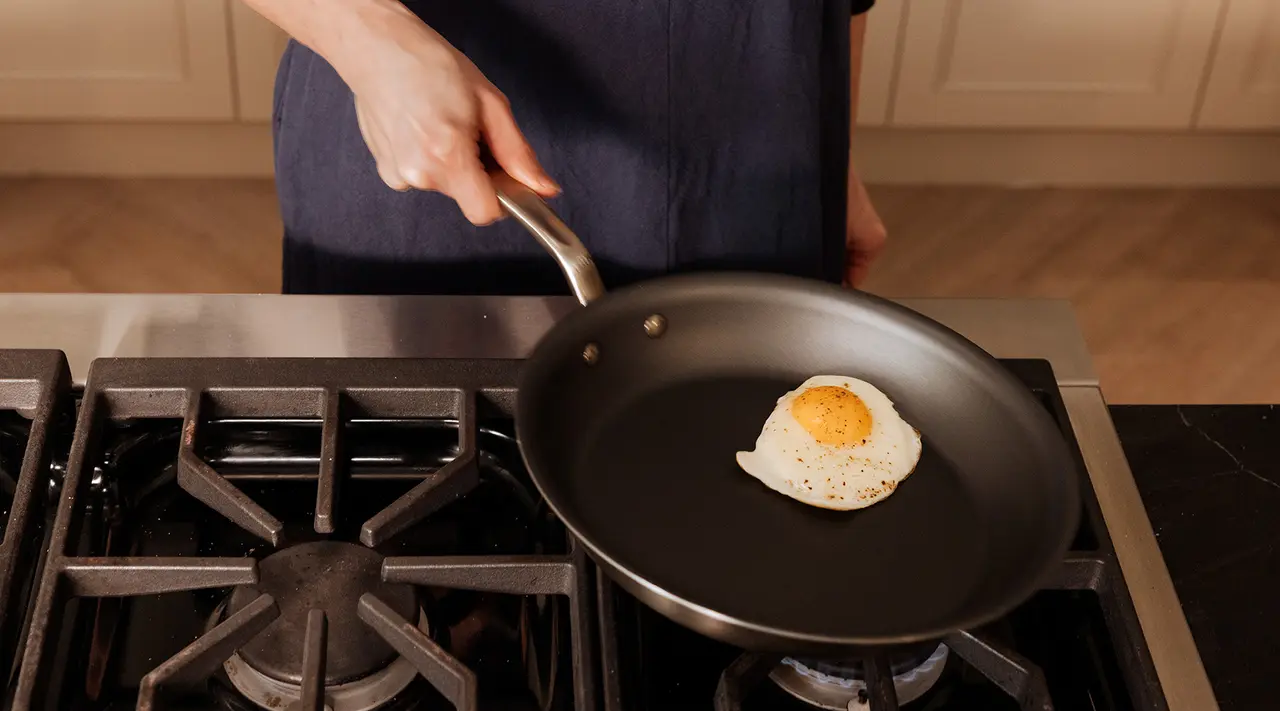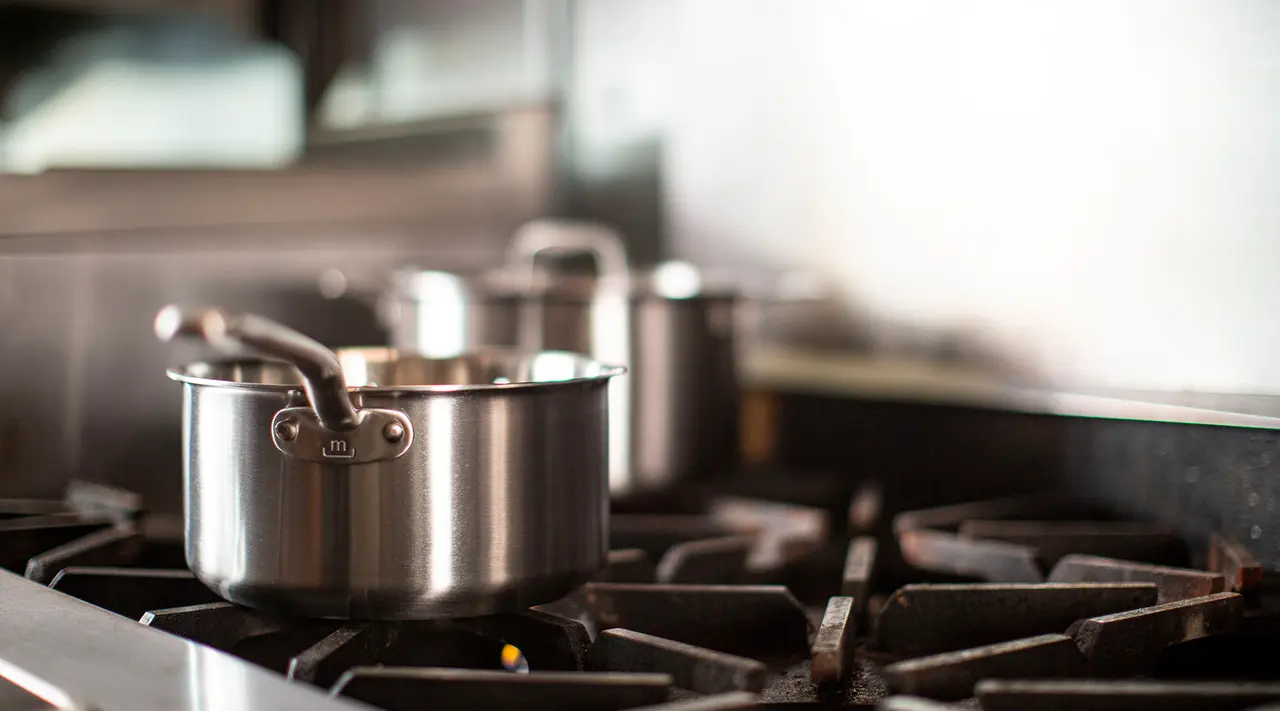We know from experience—i.e., thousands of broken yolks and rubbery whites—that a good pan can make a huge difference when cooking eggs. While this largely depends on how you’re cooking your eggs, you’ll generally want to look for a pan that heats evenly and responds rapidly. Since eggs can overcook in a matter of seconds, the ability to quickly cut the heat and halt cooking can be the difference between perfectly set and rubbery.
Here, we take you through the best pans for cooking up all of your favorite egg recipes, from scrambled to quiches. Read on to learn why non stick is best for custardy scrambles, how stainless clad can help you achieve jammy perfection, and more.
- What’s the Best Pan for Fried Eggs?
- For Perfectly-Set Poached Eggs: Stainless Clad Saucepan
- For Diner-Style Eggs: Carbon Steel Griddle
- For Easy-to-Peel Boiled Eggs: Stainless Clad Saute Pan
- For Crispy Frittatas: Enameled Cast Iron Skillet
- For Family-Sized Quiches: Porcelain Bakeware
- For Fluffy Omelettes: Non Stick Frying Pan
What’s the Best Pan for Fried Eggs?

The Made In Kitchen team knows that the pan used to cook a fried egg can make or break the finished product. That’s why they put four pans—Enameled Cast Iron Skillet, Non Stick, Stainless Clad, and Carbon Steel—to the test to see which one yielded the ultimate fried egg.
While Non Stick will always be our old reliable when making dishes like fried eggs, two unsuspecting winners came out of this: Enameled Cast Iron and Stainless Clad. Check out the video above to figure out why.
For Perfectly-Set Poached Eggs: Stainless Clad Saucepan

Tender and wobbly with a gooey, just-set yolk, a perfect poached egg is hard to beat (especially on top of crisp asparagus spears topped with some hollandaise)—yet poaching can be tricky to get right.
For consistent results, we recommend using a stainless clad saucepan. The cladded construction offers excellent temperature control and heat retention, making it much easier to achieve—and maintain—the gentle simmer you’ll need for proper poaching. Depth is also key—make sure the pan you’re using is deep enough to keep the white from sticking to the bottom. For poaching eggs in batches, we’d recommend using something with a bit more volume, like a saute pan or stock pot.
For Diner-Style Eggs: Carbon Steel Griddle

Want a pan that can cook eggs over easy, crispy hashbrowns, and a side of bacon all at the same time? A wide griddle that fits over two burners (or an outdoor grill) is your best bet, like Made In’s. A carbon steel griddle gives you plenty of space to cook up a complete diner-style breakfast for your whole family without the risk of overcrowding (the pan, not your breakfast table—we can’t help you there). We even like to toast our bread on it.
If you prefer a golden brown American-style omelette to a French-style rolled omelette, a griddle is a great option. Since this griddle is designed for dual-zone cooking (and since carbon steel responds so well to temperature change), you can keep the heat low on one end for your eggs and high on the other for bacon.
For Easy-to-Peel Boiled Eggs: Stainless Clad Saute Pan
Whether you like your eggs hard boiled, soft boiled, or with jammy yolks, a saute pan is tough to beat for boiling eggs. A 3.5QT saute pan allows plenty of room for hot water to circulate, ensuring perfectly-set, jammy centers.
Because the Stainless Clad construction also offers great heat retention, your water will stay at a boil even after you’ve dropped your eggs in, and keep that boil going for as long as you need.
For Crispy Frittatas: Enameled Cast Iron Skillet
With its smooth, easy-to-clean surface and cast iron core, an enameled cast iron skillet is our absolute favorite tool for frittatas. This pan makes for an evenly golden brown exterior with a tender, custardy (but never runny) center, even with lots of delicious add-ins like sausage or veggies. Since it’s oven safe, you can also finish your dish under the broiler for the perfect golden brown top. We’d also use this pan for frying or scrambling eggs or for cooking a single, American-style omelette.
For Family-Sized Quiches: Porcelain Bakeware
For custardy egg-heavy dishes like quiche, strata, or even baked french toast—which need even, gentle heat to avoid turning out scrambled and rubbery—we turn to porcelain bakeware. In addition to being beautiful, porcelain is highly durable and heat retentive, allowing you to reach higher temperatures needed for caramelizing and browning. But it’s also slower and gentler to heat up, so the filling won’t overcook or split and you can avoid a soggy bottom crust.
Made In’s porcelain Pie Dish is great for traditional round quiches, and a Baking Slab or Rectangular Baking Dish are good options for large-format quiches, casseroles for a crowd, and shirred eggs, which benefit from the same gentle heat.
For Fluffy Omelettes: Non Stick Frying Pan

We'll say it again: Non Stick is the most superior option for most egg dishes, especially omelettes. The range of sizes our Non Stick Pan is available in means you can make omelettes to your liking—use 8" for a thick and fluffy one, 10" to load it up with toppings, and 12" for thin, French-style ones. No matter if you choose one pan or all three, you're guaranteed an easy, no-stick cooking experience.
Ready to Cook?
If you love eggs as much as we do, you’ll never run out of new ways to cook them—even if all you have is a non stick frying pan (though we highly recommend picking up one or two of the other pans we mentioned). Our Test Kitchen put four of our frying pans to the test to see which one reigns supreme when cooking a classic fried egg—and the answer may surprise you.
Whatever eggy dishes you’re cooking up, it helps to have a set of Mise en Place bowls or ramekins handy for organizing frittata and omelet ingredients, or for sliding eggs gently into simmering water for poaching.






































